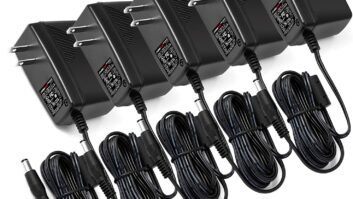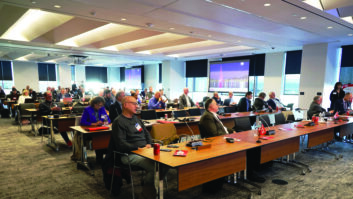Wheatstone Corp. Research and Development Engineer Dave Breithaupt will speak at the NAB Show about Ethernet switches as used in IP audio networks.

This slide from Breithaupt’s presentation shows differences in traffic between a typical office network and a typical small AoIP network.RW: You subtitled your talk “Stranger in a (Very) Strange Land.” Why, what is strange about it?
Breithaupt: In a broadcast facility, the mics, consoles and other broadcast equipment are very much at home. We design these products specifically for broadcast use. They’re built to endure in a 24 hour, continuously operating broadcast environment. Broadcasters are comfortable with these products. They know how to use them, install them and maintain them.
But the switch comes from this other world — the IT world — and suddenly broadcasters are dropping a switch into the middle of all that broadcast equipment. There are some very real considerations when you merge these two worlds.
Setting up an IP audio network isn’t at all like setting up any other Ethernet network. You need to carefully consider the role of the switch.
RW: Why is the switch so important?
Breithaupt: In the world of IP audio, the switch is the routing system. Signals are switched and dispatched by the switch itself, under the control of the IP audio protocol that’s in use. The stability and reliability of the system as a whole are a direct function of the switches used.
RW: Obviously details of your presentation are beyond the scope of this interview; but can you list some tips on what to look for in a switch for AoIP, for the kind of streaming our readers must do?
Breithaupt: The switch needs to be as solid and reliable as possible. The switch fabric should be robust and of sufficient capacity to handle the sustained high data rates present on an IP audio network. If the system is large, the switches used should be capable of maintaining large multicast group tables to provide sufficient IP audio paths for the system’s signals. And it must be managed so that its operating parameters can be optimally set.
RW: What’s the difference between managed and unmanaged switches?
Breithaupt: Unmanaged switches are the sort of switches you’d buy off-the-shelf at an office supply store. They often have low capacity; and while they’re reliable enough for use in a small or home office, they are generally of low capacity and quality. They have no configuration or controls to speak of; they’re simply plug-and-go. In general, they have no place in the demanding world of audio over IP.
Managed switches offer the engineer an interface by which he can configure the switch — for example, to set it up with multiple VLANs, or set up multicast operation, or enable or disable certain features, and often they also have facilities for monitoring and evaluating network operation.
RW: Briefly, how successful has our industry become at mitigating packet losses?
Breithaupt: The use of reliable, fast Gigabit Ethernet networks has given us sufficient network capacity to avoid lost packets.
RW: What is the impact of AES67 on switch selection?
Breithaupt: There is, for all practical purposes, no impact. AES67 has no specific requirements for a switch.
RW: What is the most common error that engineers make in this area?
Breithaupt: Allowing the station’s IT department to maintain control over switches used in the audio over IP environment. General IT engineers have no concept of AoIP’s nature or requirements and will often cause problems when trying to treat these switches as standard enterprise network components. Also, going cheap is a common pitfall. Since switches are so important, skimping here is a bad choice.
RW: So: Who should handle the station’s switches? The IT guys or the audio guys?
Breithaupt: As above. Engineering, not IT. Audio over IP is not at all like general enterprise or office networking.
RW: Anything else engineering readers should know?
Breithaupt: Careful management, not just of switches but of network infrastructure in general, is the best way of ensuring a reliable, high-capacity AoIP network. It’s also important to keep AoIP networks isolated from general enterprise or business networks, via VLAN or preferably via physical separation. If VLANs are used, the configuration must be under the control of the IP audio engineer, not the IT guy!












